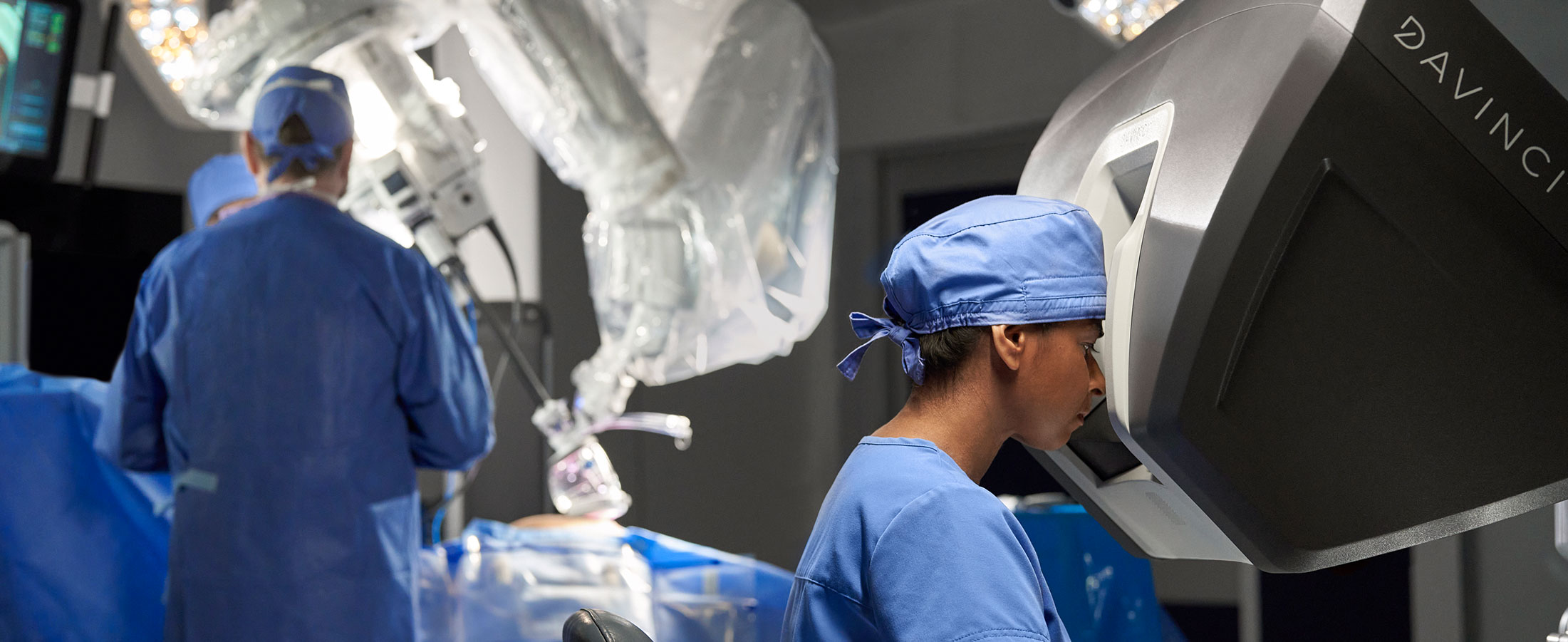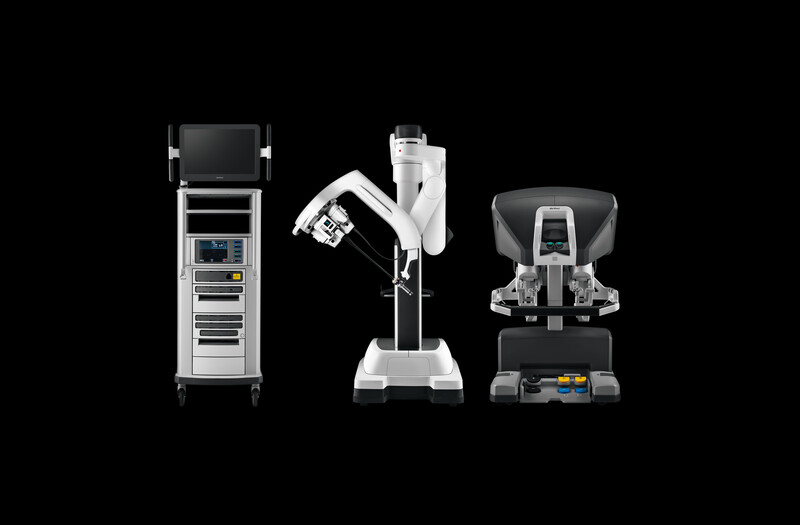

Learning you have a medical condition that requires surgical intervention can be devastating. In addition to thinking about the outcome, it’s only natural to wonder how this could affect your daily life. ‘What about my family? What about work? I have things to do, bills to pay.’
Medical procedures have evolved greatly through the years, from open surgery and laparoscopy to robotic surgery. Intuitive is in constant pursuit of developing systems and technologies that help surgeons care for their patients effectively with as little trauma and downtime as possible. Over nearly three decades, Intuitive has successfully launched several generations of the da Vinci multiport system, then expanded its portfolio with da Vinci SP (a single-port robotic solution) in 2018.
For patients to experience the potential benefits of robotic surgery, surgeons needed to believe in the new system, adapt, and learn new skills. Dr. Michael Stifelman, chair of urology and director of robotic surgery, and Dr. Mutahar Ahmed, urology specialist, of Hackensack University Medical Center, did just that.
Dr. Ahmed shares, “Initially when we were using da Vinci SP, we were trying to copy what we were doing with da Vinci Xi. But then as we got used to it, we asked, ‘Can I do something differently to get to where I want to go?’” He continues, “When a new technology comes out, if your mind is open to it, you can always learn something new and perhaps do it better. Why not take advantage of that?”
Acquiring new skills takes time, patience, and a willingness to do things differently—something that rings true for the transition from da Vinci Xi procedures to surgeries with da Vinci SP.
It’s questions like these that signal the mindset of an innovator. There’s a consistent determination to explore, learn, and make improvements. Intuitive has shared that mindset with pioneering surgeons since the company’s debut in the 90s. Can medical interventions be less invasive? Can the experience be improved for patients and surgeons alike?
The expansion of Intuitive’s portfolio to include a single-port solution was an innovative next step in the company’s journey to deliver an even less invasive approach to da Vinci surgery. In the United States, da Vinci SP is indicated for urological and transoral procedures.

Dr. Stifelman explains, “We can do very complex reconstructive procedures through just a small incision in the patient’s belly button where it’s completely hidden.” Surgeons have leveraged the robotic system for narrow and alternative access surgeries including partial nephrectomy, total nephrectomy, and extraperitoneal prostatectomy, with other indications at varying stages of use and testing globally.
Dr. Ahmed explains, “To do an open surgery you have to stick your hand in. With the single port, you don’t have to disturb all that tissue because you are going right to the source.” According to Dr. Stifelman, many of his patients appreciate the reduced scarring from single-incision surgery.
Learn the fundamentals, finetune newly acquired skills, operationalize, and scale. This is the experience Dr. Ahmed recounted at Intuitive Connect 2023—an annual event for surgeons and hospital leaders to learn from leading robotic surgeons who utilize da Vinci surgical systems in their practice.
Dr. Ahmed, whose first da Vinci SP case took place in January 2019, described his need for more operative time. He shared that his case volume was around 300 cases annually before da Vinci SP, and how the expansion of its use increased his case volume over the years. He noted that while he did still use da Vinci Xi for certain cases, the vast majority utilized da Vinci SP.
Between 2021–2023, he developed and implemented a flip room strategy—an operational decision to allocate two rooms to one surgeon simultaneously. Put simply, this allowed him and his team to operate in one room while the other room was being prepped for the next patient, leading to smoother transitions and less down time. In 2022 Dr. Ahmed’s volume rose to nearly 450 da Vinci cases, then 550 cases in 2023.
Dr. Stifelman summarizes, “We all have realized that adopting this technology has made us better surgeons, and it’s allowing us to train the next generation of surgeons more effectively.” As robotic surgery adoption grows and more indications become a reality, the feedback loop between Intuitive, surgeons, and hospitals will continue to expand. The surgical pioneers paved the way, and more surgeons with diverse specialties are following suit.
Dr. Stifelman shares, “One question I hear is, ‘Why use SP, is it really better?’ And I think it’s remembering the lessons from the initial robotic platform we had and seeing how that transformed what we did. Through perseverance, through collaboration with colleagues, and through sharing ideas we really overcame that.” At the heart of it, surgeons are lifelong learners who want the best for their practices and most of all—for their patients.

Look for more Intuitive stories on leadership, problem solving, and impact at the point of possibility™.
Financial disclosure
The independent healthcare professional quoted on this website has received compensation from Intuitive for consulting and/or educational services. The material presented represents the views, experiences, and opinions of independent surgeons based on their practice and personal experience performing surgery with the da Vinci surgical system. Their experience may or may not be reproducible and is not generalizable.
Surgeon disclosure
The material presented represents the views, experiences, and opinions of independent surgeons based on their practice and personal experience performing surgery with the da Vinci surgical system. Their experience may or may not be reproducible and is not generalizable.
Important safety information
Serious complications may occur in any surgery, including surgery with a da Vinci system, up to and including death. Examples of serious or life-threatening complications, which may require prolonged and/or unexpected hospitalization and/or reoperation, include but are not limited to, one or more of the following: injury to tissues/organs, bleeding, infection, and internal scarring that can cause long-lasting dysfunction/pain.
Risks specific to minimally invasive surgery, including surgery with a da Vinci system, include but are not limited to, one or more of the following: temporary pain/nerve injury associated with positioning; a longer operative time, the need to convert to an open approach, or the need for additional or larger incision sites. Converting the procedure could result in a longer operative time, a longer time under anesthesia, and could lead to increased complications. Contraindications applicable to the use of conventional endoscopic instruments also apply to the use of all da Vinci instruments.
For important safety information, including surgical risks and considerations, please also refer to www.intuitive.com/safety. For a product’s intended use and/or indications for use, risks, full cautions and warnings, please refer to the associated user manual(s).
Individual outcomes may depend on a number of factors, including but not limited to patient characteristics, disease characteristics, and/or surgeon experience.
Da Vinci SP system (TORS and URO)
The safety and effectiveness of this device for use in the performance of general laparoscopic surgery procedures have not been established. This device is only intended to be used for single port urological procedures and for transoral otolaryngology surgical procedures in the oropharynx for benign tumors and malignant tumors classified as T1 and T2 with the da Vinci EndoWrist SP Instruments and the da Vinci SP surgical system (SP1098).